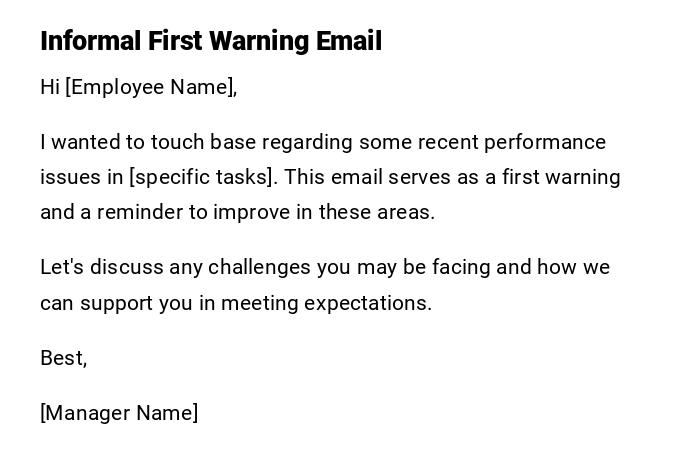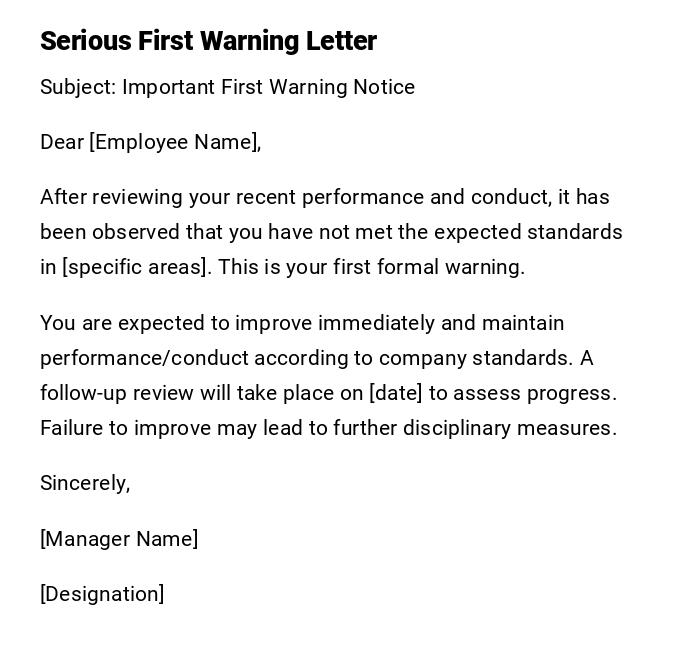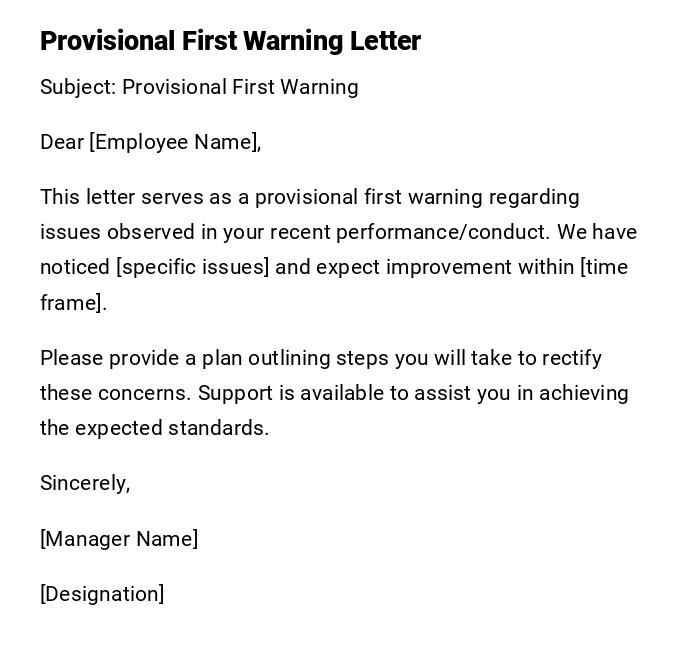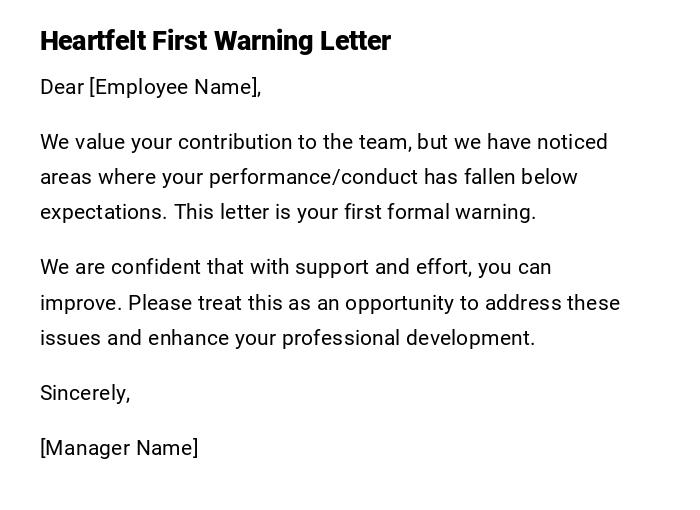First Warning Letter
[Your Name]
[Your Address]
[City, State, Zip Code]
[Email Address]
[Phone Number]
[Today's Date]
[Employee's Name]
[Employee's Address]
[City, State, Zip Code]
Subject: First Warning Letter
Dear [Employee's Name],
I hope this letter finds you well. I am writing to address some concerns that have come to our attention regarding your job performance and conduct at the workplace. As an organization, we value the contributions of each employee, and it is essential that all team members maintain a high standard of professionalism and dedication to their responsibilities.
The purpose of this letter is to issue you a First Warning due to the following issues:
1. **Attendance**: We have noticed that your attendance has been inconsistent recently. Punctuality and regular attendance are crucial for the smooth functioning of our team and to meet our organizational objectives.
2. **Quality of Work**: There have been instances where the quality of your work did not meet the expected standards. It is essential to deliver outputs that are accurate, well-executed, and aligned with our company's guidelines.
3. **Communication**: Effective communication is vital in a collaborative work environment. We have received feedback from colleagues and supervisors about your need to improve in this area, both in written and verbal communication.
4. **Adherence to Company Policies**: It has come to our attention that you have violated some of our company policies. As an employee, it is crucial to comply with all policies and procedures to maintain a positive work environment.
Please note that this warning is not a termination of your employment, but rather a formal notice to address these concerns promptly. We believe in providing our employees with the opportunity to improve their performance and conduct.
To rectify these issues, we expect the following actions from you:
1. **Improved Attendance**: Ensure punctuality and regular attendance. In case of any emergencies or unforeseen circumstances, promptly inform your supervisor as per company protocol.
2. **Enhanced Work Quality**: Pay attention to the quality of your work and seek feedback from your supervisor if necessary. Take the necessary steps to improve the accuracy and precision of your deliverables.
3. **Effective Communication**: Work on improving your communication skills, both written and verbal. Listen actively and express yourself clearly and professionally.
4. **Adherence to Company Policies**: Familiarize yourself with all company policies and adhere to them strictly.
To support your improvement, we will schedule regular meetings with you to provide feedback and assess your progress. Failure to demonstrate significant improvement within the specified timeframe may result in further disciplinary action, up to and including termination of your employment.
Please sign and return a copy of this letter to indicate your understanding of its contents. You may also use this opportunity to provide any additional information or concerns you may have.
We genuinely hope that this warning serves as a catalyst for positive change and that we can work together to overcome these challenges. If you require any assistance or have any questions, do not hesitate to reach out to your supervisor or the HR department.
Sincerely,
[Your Name]
[Your Job Title]
[Company Name]
I acknowledge receipt of this First Warning Letter:
____________________________
[Employee's Signature] [Date]
Formal First Warning Letter for Unsatisfactory Conduct
Subject: First Warning Regarding Performance/Conduct
Dear [Employee Name],
This letter serves as a formal first warning concerning your recent performance/conduct in your role as [Position]. Specific areas of concern include [list specific issues].
We expect immediate improvement in these areas. Please consider this letter as an official notice. Continued unsatisfactory performance/conduct may result in further disciplinary action, including potential termination.
Kindly acknowledge receipt of this letter and take the necessary corrective actions.
Sincerely,
[Manager Name]
[Designation]
Informal First Warning Email
Hi [Employee Name],
I wanted to touch base regarding some recent performance issues in [specific tasks]. This email serves as a first warning and a reminder to improve in these areas.
Let's discuss any challenges you may be facing and how we can support you in meeting expectations.
Best,
[Manager Name]
Serious First Warning Letter
Subject: Important First Warning Notice
Dear [Employee Name],
After reviewing your recent performance and conduct, it has been observed that you have not met the expected standards in [specific areas]. This is your first formal warning.
You are expected to improve immediately and maintain performance/conduct according to company standards. A follow-up review will take place on [date] to assess progress. Failure to improve may lead to further disciplinary measures.
Sincerely,
[Manager Name]
[Designation]
Provisional First Warning Letter
Subject: Provisional First Warning
Dear [Employee Name],
This letter serves as a provisional first warning regarding issues observed in your recent performance/conduct. We have noticed [specific issues] and expect improvement within [time frame].
Please provide a plan outlining steps you will take to rectify these concerns. Support is available to assist you in achieving the expected standards.
Sincerely,
[Manager Name]
[Designation]
Heartfelt First Warning Letter to Encourage Improvement
Dear [Employee Name],
We value your contribution to the team, but we have noticed areas where your performance/conduct has fallen below expectations. This letter is your first formal warning.
We are confident that with support and effort, you can improve. Please treat this as an opportunity to address these issues and enhance your professional development.
Sincerely,
[Manager Name]
What / Why of a First Warning Letter
Purpose of a First Warning Letter
- A first warning letter is a formal document issued to an employee to highlight performance or conduct concerns.
- It serves to inform the employee about areas requiring improvement.
- Provides documentation for the organization in case further disciplinary action is needed.
- Encourages corrective action and sets expectations for future behavior or performance.
Who Should Issue a First Warning Letter
Authorized Senders
- Immediate supervisors or managers of the employee.
- HR personnel may co-author or approve for compliance.
- Department heads in cases of serious performance or conduct issues.
Whom the First Warning Letter Should be Addressed To
Recipients
- Directly to the employee whose performance or conduct is being addressed.
- HR may receive a copy for official records.
- Supervisors or management may also keep a copy for reference.
When to Issue a First Warning Letter
Trigger Scenarios
- When an employee’s performance or conduct falls below the expected standards.
- After verbal warnings or informal discussions have been provided.
- To formally document the issue for accountability.
- As the initial step in a progressive disciplinary process.
How to Write and Send a First Warning Letter
Writing and Sending Process
- Identify specific performance/conduct issues with examples.
- Keep language clear, professional, and objective.
- State expectations and timelines for improvement.
- Explain consequences for continued issues.
- Offer support or resources for improvement.
- Send via official email or printed letter with acknowledgement.
- Document the issuance for HR records.
Requirements and Prerequisites for Issuing a First Warning Letter
Checklist Before Sending
- Evidence of performance/conduct issues (reports, metrics, observations).
- Records of previous verbal counseling or informal discussions.
- Alignment with company HR policies and guidelines.
- Clarity on measurable expectations for improvement.
- Agreement from HR or management if required.
Formatting Guidelines for a First Warning Letter
Formatting Tips
- Length: One page is sufficient; concise but comprehensive.
- Tone: Professional and neutral, avoiding emotional or accusatory language.
- Style: Formal for official documentation; informal reminders can use casual style.
- Structure: Subject line, greeting, description of issue, expectations, consequences, closing.
- Include: Signature, date, and HR notation if necessary.
After Sending a First Warning Letter
Follow-up Steps
- Monitor employee performance/conduct after issuance.
- Schedule a review meeting within the stated timeframe.
- Document progress or lack thereof in HR records.
- Consider further action if no improvement is observed.
- Provide ongoing support and feedback as necessary.
Pros and Cons of Issuing a First Warning Letter
Advantages
- Clearly communicates areas needing improvement.
- Provides an official record for HR and management.
- Encourages corrective action without immediate severe consequences.
Disadvantages
- May cause stress or reduced morale if not communicated tactfully.
- Could create tension between employee and manager.
- Requires ongoing monitoring and follow-up by management.
Common Mistakes in First Warning Letters
Mistakes to Avoid
- Being vague about the issues.
- Using accusatory or emotionally charged language.
- Failing to provide clear expectations or timelines.
- Issuing without prior verbal counseling or informal notice.
- Neglecting HR or company policy compliance.
Key Elements and Structure of a First Warning Letter
Essential Components
- Subject line indicating purpose.
- Greeting.
- Specific description of performance/conduct issues.
- Reference to prior informal discussions if any.
- Expectations and required improvements.
- Timeline for review.
- Consequences for continued issues.
- Closing and signature.
- Date and HR record notation.
Tricks and Tips for Effective First Warning Letters
Best Practices
- Keep tone professional, objective, and constructive.
- Provide actionable guidance for improvement.
- Use measurable indicators to assess progress.
- Document all communications for accountability.
- Offer support or training where needed.
- Follow up consistently within the set timeframe.
Compare and Contrast First Warning Letters with Other Disciplinary Actions
Comparison
- Verbal Warning: Less formal, no permanent record; used for minor issues.
- First Written Warning: Formal, documented, sets clear expectations and consequences.
- Final Warning: Issued after first warning fails to result in improvement; more serious consequences.
- First warning letters serve as the initial formal step to encourage correction before escalating disciplinary action.







 Download Word Doc
Download Word Doc
 Download PDF
Download PDF